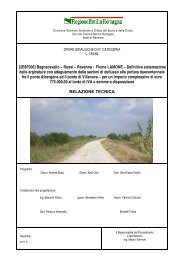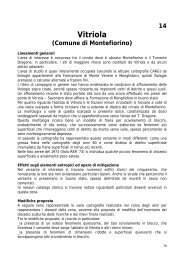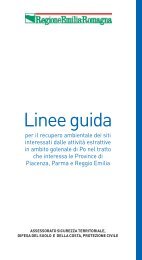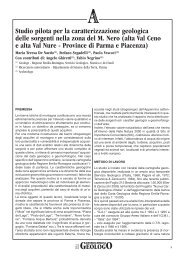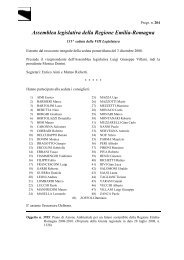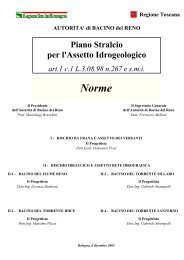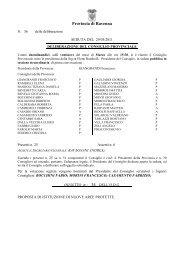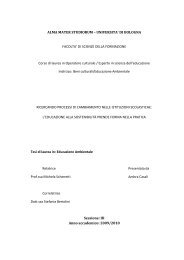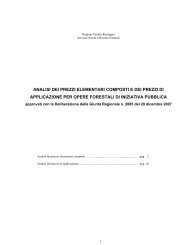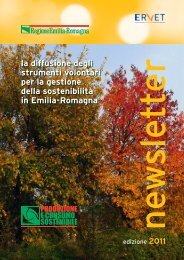air, water and soil quality qualité - ER Ambiente - Regione Emilia ...
air, water and soil quality qualité - ER Ambiente - Regione Emilia ...
air, water and soil quality qualité - ER Ambiente - Regione Emilia ...
Create successful ePaper yourself
Turn your PDF publications into a flip-book with our unique Google optimized e-Paper software.
for <strong>soil</strong>s, it sums up at a total surface of 210.000 km2. Now it can be concluded that<br />
for example the total surface of Germany (about 367.000 km2) is contained in 1.7<br />
ha of <strong>soil</strong> <strong>and</strong> 20 cm depth.<br />
constituents of the inner <strong>soil</strong> surface (e.g. clay minerals, oxides, o.m.), their<br />
specific structures <strong>and</strong> electrical charges (positive/negative);<br />
environmental influence;<br />
specific <strong>soil</strong> parameters;<br />
<strong>soil</strong> microbes behavior;<br />
P availability.<br />
Estimation of time dependent degradation rates <strong>and</strong> consequently risks involved is<br />
very important (e.g. glyphosate biodegradation at the beginning is generally fast,<br />
then slower- with enhanced adsorption processes; Glyphosate leaching <strong>and</strong> surface<br />
runoff-risk is bigger with the rain immediately after the application, before the<br />
plants could adsorb it) (Eriksson et al., 2007; Peruzzo et al., 2008; Zaranyika <strong>and</strong><br />
Ny<strong>and</strong>ro, 1993; Siimes et al., 2006).<br />
Glyphosate sorption in <strong>soil</strong>. Strong sorption of glyphosate to <strong>soil</strong> particles may<br />
decrease degradation rate of glyphosate due to less bioavailability of bounded pesticide.<br />
Glyphosate adsorption on <strong>soil</strong> colloids;<br />
Fe/Al-oxides, clays, calcite, organic matter (?);<br />
Glyphosate complexation with metals.<br />
Availability of glyphosate for decomposition is affected by the rate of desorption.<br />
(Eberbach, 1997; Gimsing et al., 2004; Schnurer et al., 2006; Sørensen et al., 2006;<br />
Rodrígez-Cruz et al., 2006; Kools et al., 2005; Ghanem et al., 2007)<br />
Glyphosate fate is affected by the <strong>soil</strong> processes <strong>and</strong> their influence on <strong>soil</strong> microbial<br />
population <strong>and</strong> activity. Numerous investigations have shown that the next<br />
factors have great influence on pollutant fate in different <strong>soil</strong>s (Mamy et al., 2005;<br />
Albrechsten et al., 2001; Eberbach, 1997; Blume et al., 2002; Kools et al., 2005;<br />
Stenrød M et al., 2005; Stenrød M et al., 2007; Matthies et al., 2008; Fenner et al.,<br />
2005):<br />
Temperature<br />
Moisture<br />
pH<br />
Aerobic/anaerobic conditions (redox conditions).<br />
Sorption of glyphosate in <strong>soil</strong> is mainly due to the inner sphere complex formation<br />
with metals of <strong>soil</strong> oxides, related to the <strong>soil</strong> phosphate adsorption capacity.<br />
Possible binding mechanisms:<br />
Electrostatic bonds in extremely acid media<br />
Hydrogen bonds with humic substances<br />
Especially, covalent bonds with Fe <strong>and</strong> Al oxides.<br />
105



